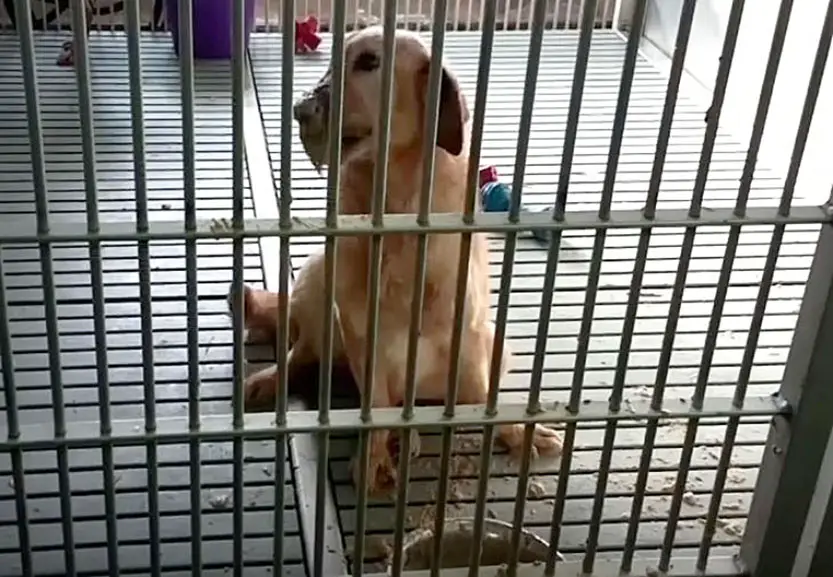Jelly’s Story Is Why Experimenting on Animals Must End
Tags: opinion
Jelly had a sad story to tell and showed us that experimenting on animals should end. Such a question has been a great topic for debates and might be going on for several years to come.
The Laboratory That Practices Secret Experimenting On Animals
Several golden retrievers and Labrador mixes are kept captive in an unmarked building in Texas. You can be sure that most of these dogs will never find another home.
This building, from the outside, looks like a dog pound, with metal kennels and slatted floors. The sick dogs living there, are always quiet while the healthy ones keep jumping and sticking their noses between the metal bars of their cages.
READ: LIVE PIGS USED AS CRASH TEST DUMMIES IN HIGH SPEED EXPERIMENTS
The officials from the university stated that strict confidentiality protects the dogs and their caretakers from activists, which is why the location is kept a secret.
Several animal welfare groups are of the opinion that these dogs need protection from the University, itself.
These canines live on the campus because the researchers at Texas A&M need them to study Duchenne muscular dystrophy. This is a degenerative disease that is terminal for young kids. Scientists are experimenting on animals to find a cure or a treatment that can lengthen the lives of the suffering people.
Experimenting On Animals: A Controversial Topic To Discuss
Such a thing is quite controversial as medical research made on cats and dogs is declining rapidly. This laboratory had recently attracted several protests, death threats, and harassment from violent activists, who are desperate to shut down the experimenting on animals. The officials at texas A&M are unmoved and are motivated to save human lives for a small price.
READ: NEARLY 60 YEARS ON, THE CIA’S SECRET LSD EXPERIMENTS HAVE BEEN REVEALED
Texas A&M Shares Their Perspective On Such Experimentation
Dr. Eleanor Green, who is the dean of Texas A&M School of Veterinary Medicine and Biomedical Sciences, stated that “What this is a philosophical divide among those who do not believe in any animal research and those of us who devote our lives to animals, and realize that at this point animal research is still necessary. One day, maybe we won’t need it. And it’s becoming less and less, but until that day comes, we believe it’s necessary.”
The university has hidden the laboratory for 7 years and has denied visitors, rejected media interviews, and lied about how the researchers had obtained the animals.
Officials at the university, last month, had granted The Dallas Morning News limited access to the dog colony and laboratory but banned a reporter from taking any photos or video. They wanted everyone to know that the animals were treated with great care.
There are approximately 40 dogs on the campus, which has reduced from an initial 100. Purebred golden retrievers comprised the original group of dogs, but gradually researchers bred them with Labradors and beagle mixes to diversify the colony.
A Sad Life To Live, Jelly’s Story

PETA supporters have been fighting against experimenting on animals, for a long time, and this is where we meet a sad friend, Jelly. Jelly was born in a lonely laboratory in North Carolina. She was barely able to eat any kind of food as the researchers had bred her to have muscular dystrophy. She was only 5 years old when she was moved to Texas A&M, where she apparently got sicker. When the researchers were done with the experiments, Jelly was put to death.
“Jelly had lived a painful life, for no reason”, which was preached by the PETA officials.
PETA has suggested that such experiments have never yielded any cures and dogs like her were still suffering in the secret laboratory, where they were experimenting on animals.
Texas A&M has responded to several stories about PETA’s latest campaign by denying any cruelty. But they have also erroneously denied that they were breeding dogs for research.
School officials told several media organizations that the dogs used in the research were “already affected” with Duchenne and “not artificially made to be sick.”
SUPPORT US ON PATREON AND GET ACCESS TO OTHER EXCLUSIVE CONTENT, CLICK HERE TO LEARN MORE
FOLLOW MIKE ON INSTAGRAM FOR MORE: @MIKESYGULA
Leave Comment: